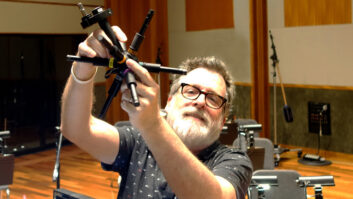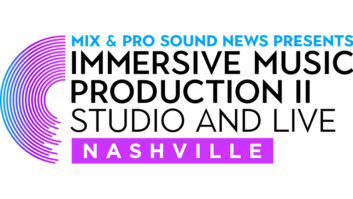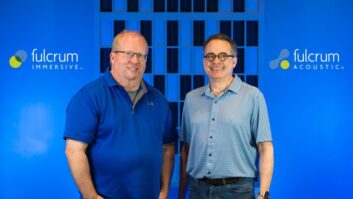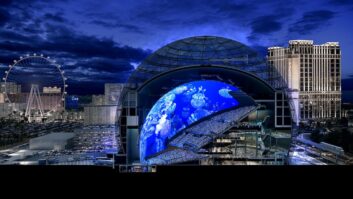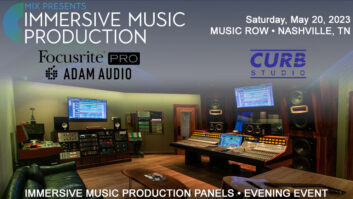Ben Maas programmed the Soundcraft Vi4 at the Ojai Music Festival’s FOH position to generate more sends than in the past. OJAI, CA—Established in 1947, the Ojai Music Festival presents an eclectic and challenging program curated each year by a guest music director, who this year was classical pianist Jeremy Denk. Held over four days in June, this year’s festival featured an immersive PA configuration supplied by Schubert Systems at the centerpiece Libbey Bowl, where head engineer Ben Maas mixed performances ranging from classic works by Beethoven, Mozart and Schubert to modern pieces by Ives, Ligeti and Stockhausen.

Libbey Bowl, completely remodeled in 2011, seats 970; an upper lawn area expands capacity to around 1,300. Maas, of Fifth Circle Audio, in his seventh year as festival FOH mixer, has adapted the sound design over the years to focus on two issues.
“The first is for the people in the bowl seats, providing them with an experience that’s a little closer to a concert hall,” he says. “I’ve got a Lexicon 960; I can give them a little more intimacy, but also open up the sound and make it not feel like it’s quite so outdoors.”
The second issue is one of spatialization and localization of performers. For example, he says, “We have a piece where there are going to be some chimes off to the left; I can localize that sound. People are not going to have the disconnect of seeing somebody off to the left but hearing it from in front of them.”
Schubert Systems, based 75 miles away in Los Angeles, supplied a mix of d&b audiotechnik models for the company’s first year as festival production provider. The rig was configured as a 7.1 system for the bowl seating, with stereo or mono delays for the lawn.
For the bowl, small left and right hangs of V8 and V12 arrays with V Subs on the ground, plus a center T series hang, were supplemented by main left/right Q series and Q-Sub delays, says Michael Mordente, A1/system designer for Schubert Systems. “For lip fill, I used four T series. The rest of the speakers—two more series of delays—were M4s. They’re wedges, but they come with a pole stand,” says Mordente. The system was powered by D12 amplifiers controlled by R1 software.
“I basically maxed out four [Lab. gruppen] LM44 processors,” he adds. “There were multiple speakers on some of the zones. It took me almost a full day just to time-align it.”
“These d&b speakers are just amazing,” continues Maas. “In the past, I’ve never wanted to use line arrays; either left to right or vertically, you can have coloration issues, and they tend to flatten out the sound. The front-to-back image for classical stuff is just as important as left to right. The d&bs are the first line array I’ve ever heard that preserves that front-to-back depth of sound.” The coverage was even and natural sounding, he says: “You can’t tell that the sound is coming out of an amplification system. It sounds like it’s just coming from the stage.”
Maas was able to program the Soundcraft Vi4 at front of house to generate many more sends than previously possible due to the additional input (up to 96 from 72) and busing (34 stereo rather than mono) capabilities unlocked by the latest software and DSP updates. “I’m up to 40 buses to make it work: I’ve got 16 auxes, another 16 of record buses, the left and right, and a bunch of matrixes.”
The main mics pass through Pueblo preamps, says Maas, who also supplied A-Designs, API, Boulder, Forssell Technologies and Inward Connections preamps, as well as DPA, Neumann, Royer, Schoeps, Sennheiser and Sony mics, from his personal collection. The configuration of the eight stereo stems feeding the recording workstation are program- dependent, so they might include Decca tree, strings, winds and percussion, various solos and reverb returns, he says. “Those same stems are brought into the matrix for all of our delays,” he notes, allowing him to translate the bowl’s surround mix for the stereo lawn delays. “We have somebody backstage listening to the feed who makes adjustments to make sure that the recording has more of a classical rather than a sound reinforcement feel.
“Classical recordings tend to be miked a little more distantly to try to capture more of an ensemble sound. For example, we’ll take the stems with all the close mics and knock them back a few dB so we’re leaning towards the overhead mics to give us the sense of ensemble,” explains Maas, who also mixes the recordings for broadcast by American Public Media and other outlets.
Maas additionally delivered feeds to Jody Elff of Little Dog Live, who was webcasting the festival using five cameras plus a sixth at a pre-/postshow interview position. “Little Dog Live comes in with a small package that I’ve developed and pushes out a stream that looks and sounds really good,” says Elff, working the festival for the first time. “That’s a real step up from a single wide-angle shot from the back of the hall,” which is the more common approach.
“Pro Tools|HD handles all my audio and outputs digitally into a second computer that creates a layer in my Telestream Wirecast production switching software,” Elff continues. “That compiles and is pushed out as a single feed.”
Schubert also supplied Shure RF gear for the stage, including in-ears and bodypacks, reports Mordente. A DiGiCo SD9 console provided onstage monitor speaker and IEM feeds.
Schubert Systems
schubertsystems.com

